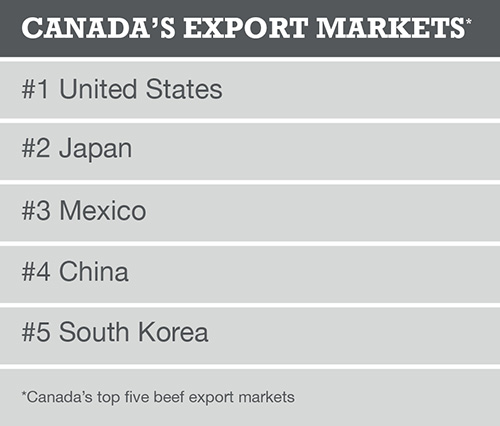
 |
|
| Cliquer ici pour lire l'infolettre en français | View in browser |
 Since the Comprehensive and Progressive Agreement for Trans-Pacific Partnership (CPTPP) came into effect, Canadian beef exports have increased 27% in volume, up 108,000 tonnes, and increased 62% in value, up $1.7 billion. Increasing exports to Japan represent roughly one quarter of that volume growth, with exports to Japan up 26,000 tonnes and $223 million between December 2018 and December 2021 (Statistics Canada). In 2021, beef exports to Japan totalled 58,149 tonnes valued at $438 million. In 2021, Japan remains behind the U.S. as Canada’s second largest beef export market by volume, since 2017. Japan’s share of market share of Canadian beef exports increased to 12% in 2021 from 8% in 2018 (Statistics Canada). Japan has consistently imported over 800,000 tonnes (USDA, cwe) of beef from the world annually since 2018, leaving room for beef export share growth. South Korea, another CPTPP member, became Canada’s sixth largest export market by volume in 2021, behind the U.S., Japan, Mexico, China, and Southeast Asia. South Korea’s market share of Canadian beef exports increased to 2.5% in 2021 from 1.1% in 2018. In 2021, beef exports to Korea at 12,888 tonnes were valued at $117 million, up from 4,439 tonnes valued at $30 million in 2018 (Statistics Canada). China is not a member of the CPTPP, although it applied to become part of the trade agreement late last year. In 2021, mainland China was Canada’s fourth largest beef export market by volume at 4.0% market share. Beef exports of 20,045 tonnes in 2021 were up 92% from 2020 and more than doubled the five-year average (Statistics Canada). Forecasting potential exports to China is challenging due to their tendency to suspend access, as was the case most recently in Canada in January 2022 following an atypical bovine spongiform encephalopathy (BSE) case announced in late December. Despite the loss of access to China this January, total Canadian beef exports from January to March 2022 were up 10% in volume and 40% in value from the year earlier period. (Statistics Canada), indicating that other markets have offset the impact of China’s closure. Over the last five years, Canadian beef exports to China throughout the year looked like an ‘m’ with seasonal increases in the spring, peaking in April, and declining over the summer to rally again to November. Considering the Chinese volume bought in 2021, and the five-year seasonality, the closure may be impacting beef exports to China to the tune of 1,700 tonnes per month. However, market access is not just about volumes. In 2021, China was a high value market at $9.65/kg, outcompeting the U.S. for beef at $9.21/kg and other CPTPP countries like South Korea at $9.10/kg. In 2019, trade access to China was closed for six months. If we assume a similar timeframe in 2022, based on 2021 volumes and values, it would represent a loss of 10,000 tonnes valued at $89 million. Since 2013, China has been a growth market for beef exports. It has become the biggest protein importer in the world, going from importing nearly nothing a decade ago to more than 300 million tonnes of beef alone in 2021. Several factors have driven this growth, but what sustains it is strong demand from the middle-class. Source: Canfax  Back to main page |
|
CONTACT US Suite 146, 6715 – 8th Street NE Calgary, AB Canada T2E 7H7 Tel: (403) 275-5890 info@canadabeef.ca canadabeef.ca |
You’re receiving this newsletter because you’ve subscribed to Canada Beef Performs. No longer interested? Forward to a friend? Comments? Email our editor at editor@newsletter.ca © 2022 Canada Beef. All rights reserved. |

|
 |